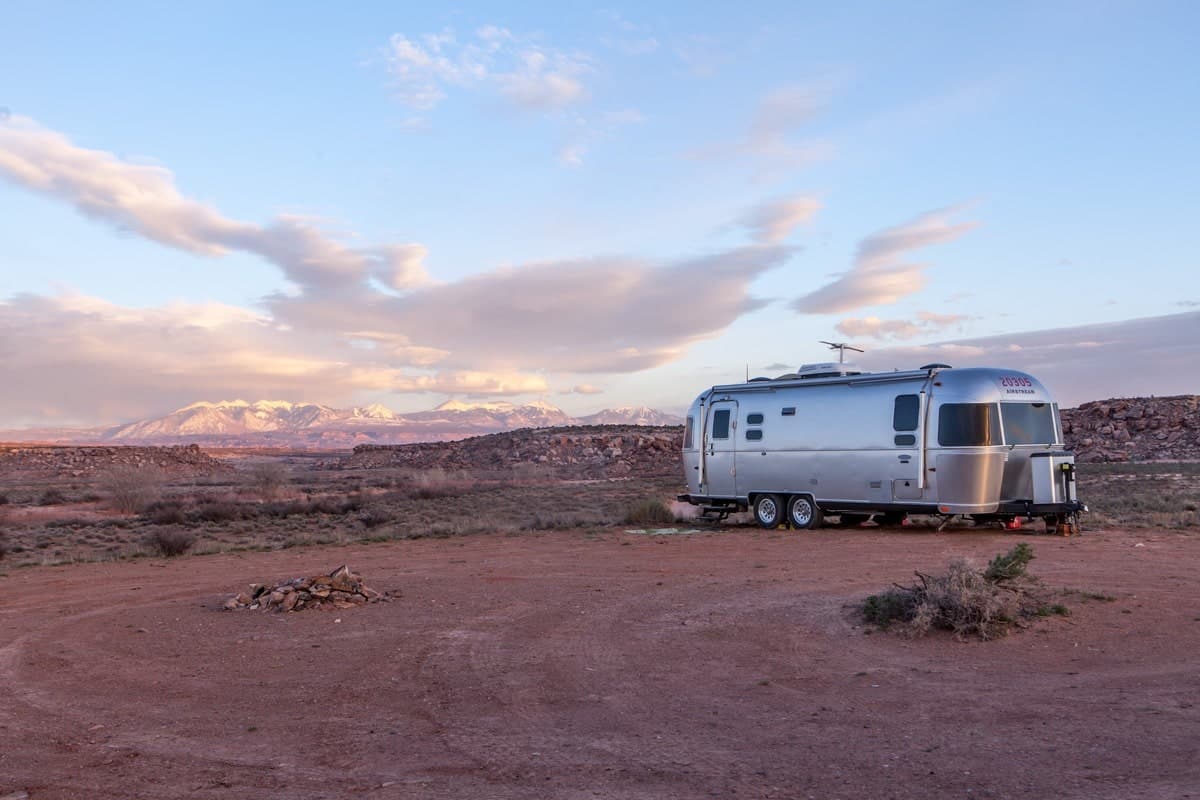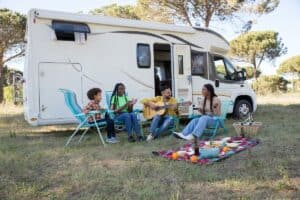Camping is one of the best ways to escape the hustle and bustle of everyday life and immerse yourself in nature. But if you’re looking for an even greater sense of adventure and freedom, you might want to try boondocking or dispersed camping. These terms may sound intimidating at first, but they simply refer to camping in undeveloped, remote areas with few or no amenities. Boondocking is often associated with RVers who prefer to camp off-grid, while dispersed camping is more commonly used in national forests where camping is allowed outside designated campsites. Regardless of which term you use, boondocking and dispersed camping offer a unique opportunity to experience the great outdoors on your own terms. In this ultimate guide, we’ll take a closer look at what boondocking and dispersed camping are, why they’re becoming increasingly popular among outdoor enthusiasts, and provide you with all the information you need to plan and enjoy your own adventure in the wild. So grab your camping gear and get ready to explore the great outdoors like never before!
What is Boondocking?
Boondocking, also known as dry camping or wild camping, refers to camping in undeveloped, remote areas with little or no amenities. Unlike traditional campgrounds, boondocking spots are often located off the beaten path, away from the crowds and noise of civilization. Boondocking is a popular activity among RVers, but it can also be done with a tent or other camping gear.
Equipment and Supplies Needed for Boondocking
Boondocking requires a bit more preparation and self-sufficiency than traditional camping. Since you won’t have access to electricity, water, or sewage hookups, you’ll need to bring all of your own supplies and equipment. Here are some essentials to consider:
- Water: Bring plenty of fresh water for drinking, cooking, and cleaning. You may also want to bring a water filter or purification system to treat water from natural sources.
- Power: Boondocking requires a self-contained power source, such as a generator, solar panels, or a battery bank. Make sure you have enough power to run your appliances, lights, and other devices.
- Sewage: You’ll need to bring a portable waste tank or other sewage disposal system to handle your wastewater. Be sure to follow proper waste disposal guidelines and regulations.
- Food and Cooking Supplies: Bring plenty of non-perishable food items, as well as a camp stove or other cooking equipment. Don’t forget utensils, dishes, and cookware.
- Camping Gear: Bring a tent, sleeping bags, and other camping gear that is suitable for the terrain and weather conditions. Be sure to pack appropriate clothing and footwear for the season.
- Navigation Tools: Since boondocking spots are often located in remote areas, you’ll need reliable navigation tools such as maps, a GPS device, or a smartphone with offline maps.
How to Find Boondocking Spots
Finding boondocking spots requires a bit of research and exploration. Here are some tips on how to find the best spots:
- Online Resources: There are many online resources and apps that can help you find boondocking spots, such as Campendium, FreeCampsites.net, and iOverlander. These websites and apps provide user-generated reviews and information about boondocking spots across the country.
- Public Lands: Many public lands, such as Bureau of Land Management (BLM) and National Forests, allow boondocking in designated areas. Check with the local land management agency for information on boondocking rules and regulations.
- Local Knowledge: Ask locals, such as park rangers or other outdoor enthusiasts, for recommendations on boondocking spots in the area. They may know of hidden gems that are not listed on popular websites.
By following these tips and being prepared with the right equipment and supplies, you can have a safe and enjoyable boondocking experience in some of the most beautiful and remote locations in the country.
Define What Dispersed Camping is
Dispersed camping is a type of camping that allows visitors to camp in designated areas outside of developed campgrounds. Unlike developed campgrounds, dispersed camping areas do not have any amenities such as water, bathrooms, or fire pits. Dispersed camping is often referred to as “boondocking,” “primitive camping,” or “backcountry camping.”
Rules and Regulations of Dispersed Camping in National Forests
Dispersed camping is a great way to experience the natural beauty of National Forests while enjoying the solitude and freedom of camping in the wild. However, there are rules and regulations that you must follow to ensure that you have a safe and enjoyable experience. Here are some general rules and regulations to keep in mind when dispersed camping in National Forests:
- Stay in Designated Areas: Dispersed camping is only allowed in designated areas within National Forests. These areas are marked with signs or other indicators. Do not camp in areas that are not designated for camping, as this can damage the environment and lead to fines.
- Practice Leave No Trace: When dispersed camping, it is essential to follow the Leave No Trace principles. This means packing out all your trash, minimizing impact on the environment, and leaving the campsite as you found it. Leave No Trace helps protect the natural beauty of National Forests for future generations.
- Observe Fire Restrictions: National Forests may have seasonal or temporary fire restrictions in place, depending on weather conditions and other factors. Always check with the local ranger station for up-to-date information on fire restrictions before starting a campfire.
- Respect Wildlife: National Forests are home to a variety of wildlife, and it is important to respect their habitat. Keep a safe distance from wildlife and never feed them. Store food and trash in bear-resistant containers or hang them from trees to prevent attracting wildlife to your campsite.
- Observe Quiet Hours: Many National Forests have quiet hours or other rules regarding noise levels. Be considerate of other campers and respect quiet hours to ensure a peaceful and enjoyable experience for everyone.
How to Find Dispersed Camping Spots
Finding dispersed camping spots in National Forests can be a bit of a challenge, but with a bit of research and preparation, you can find some incredible places to camp. Here are some tips on how to find dispersed camping spots:
- Check with the Local Ranger Station: The local ranger station is the best source of information for dispersed camping in National Forests. They can provide maps and information on designated camping areas, as well as rules and regulations to follow.
- Use Online Resources: There are many online resources that can help you find dispersed camping spots in National Forests, such as the US Forest Service website, Campendium, and FreeCampsites.net. These websites provide user-generated reviews and information on dispersed camping spots across the country.
- Explore the Area: Sometimes the best way to find dispersed camping spots is to explore the area yourself. Take a drive or hike around the National Forest and keep an eye out for signs or indicators of designated camping areas.
By following the rules and regulations of dispersed camping in National Forests and being prepared with the right equipment and supplies, you can have a safe and enjoyable camping experience in some of the most beautiful and remote areas of the country.
What is the Difference Between Boondocking and Dispersed Camping?
Boondocking and dispersed camping are terms that are often used interchangeably, but there is a slight difference between the two. Boondocking typically refers to camping in a remote or undeveloped area without any amenities, such as water, electricity, or bathrooms. Dispersed camping, on the other hand, refers to camping in designated areas outside of developed campgrounds, which may or may not have some amenities, such as pit toilets or fire rings.
Benefits of Boondocking and Dispersed Camping
There are many benefits to boondocking and dispersed camping, including cost savings, privacy, and a closer connection to nature. Here are some of the top benefits of boondocking and dispersed camping:
- Cost Savings: Boondocking and dispersed camping are often free or very low cost, which can save you a significant amount of money on your camping trip. Without the fees associated with developed campgrounds, you can stretch your camping budget further.
- Privacy: Boondocking and dispersed camping can offer greater privacy and solitude than developed campgrounds, which can be crowded and noisy. You can often find a secluded spot to set up camp and enjoy the peace and quiet of nature.
- Closer Connection to Nature: Boondocking and dispersed camping allow you to get closer to nature and experience the great outdoors in a more intimate way. You can immerse yourself in the natural surroundings and enjoy the beauty and tranquility of remote wilderness areas.
Addressing Common Concerns
While boondocking and dispersed camping can be a fantastic way to enjoy the outdoors, there are some common concerns that campers may have, such as safety and sanitation. Here are some tips on how to address these concerns:
- Safety: When boondocking or dispersed camping, it is important to take steps to ensure your safety. This includes researching the area beforehand, bringing appropriate safety gear, and being aware of your surroundings at all times. You may also want to consider camping with a buddy or a group for added safety.
- Sanitation: Without amenities such as bathrooms or trash cans, sanitation can be a concern when boondocking or dispersed camping. It is important to pack out all your trash and dispose of it properly, as well as practice Leave No Trace principles. You may also want to bring a portable toilet and/or waste bags to dispose of human waste properly.
By understanding the differences between boondocking and dispersed camping, as well as the benefits and potential concerns, you can make an informed decision about which type of camping is right for you. With proper preparation and a spirit of adventure, boondocking and dispersed camping can be a fantastic way to explore the great outdoors and connect with nature.
How to Prepare for and Enjoy Boondocking and Dispersed Camping Trips
Boondocking and dispersed camping can be a fantastic way to experience the great outdoors, but they do require a bit more preparation than camping in a developed campground. Here are some practical tips to help you prepare for and enjoy your boondocking or dispersed camping trip:
- Plan ahead: Research the area where you will be camping, including the weather, terrain, and potential hazards. Make a list of the equipment and supplies you will need and make sure to pack accordingly. Consider bringing extra food, water, and emergency supplies, such as a first aid kit and a GPS.
- Choose your campsite carefully: When boondocking or dispersed camping, you will need to choose your campsite carefully. Look for a spot that is level, dry, and free of hazards, such as dead trees or large rocks. Make sure to set up camp at least 200 feet from any water source to avoid contaminating the water and disturbing wildlife.
- Practice Leave No Trace principles: Boondocking and dispersed camping require a commitment to Leave No Trace principles, which means minimizing your impact on the environment. Pack out all trash and waste, avoid damaging vegetation or wildlife habitat, and use designated fire rings or stoves to minimize your impact on the landscape.
- Be prepared for the weather: Weather conditions can change quickly when camping in remote areas, so it’s important to be prepared for all types of weather. Bring appropriate clothing and gear for the conditions, including rain gear, warm layers, and a sturdy tent that can withstand high winds and rain.
- Stay connected: When camping in remote areas, it’s important to stay connected with the outside world in case of emergencies. Bring a fully charged cell phone, a portable charger, and a GPS device to help you navigate and communicate in case of an emergency.
Safety Considerations for Boondocking and Dispersed Camping
Boondocking and dispersed camping can be safe and enjoyable, but it’s important to take appropriate safety precautions. Here are some tips to help you stay safe when camping in remote areas:
- Stay aware of wildlife: When camping in remote areas, you may encounter wildlife, such as bears, mountain lions, or snakes. Make noise when hiking or walking to alert wildlife to your presence, keep a safe distance, and store food and other scented items in bear-resistant containers or in your vehicle.
- Be aware of potential hazards: When choosing a campsite, be aware of potential hazards such as dead trees or rocks that could fall, or low-lying areas that could flood. Make sure to choose a safe and level spot to set up camp, and avoid camping near cliffs or other steep drop-offs.
- Bring a first aid kit: When camping in remote areas, it’s important to bring a well-stocked first aid kit in case of injuries or accidents. Make sure to include items such as bandages, antiseptic, pain relievers, and a snakebite kit if you are camping in an area with venomous snakes.
- Communicate your plans: Before heading out on a boondocking or dispersed camping trip, make sure to communicate your plans with friends or family members. Let them know where you will be camping and when you plan to return, and check in with them periodically during your trip to let them know you are safe.
By following these tips and taking appropriate safety precautions, you can enjoy a safe and enjoyable boondocking or dispersed camping trip. Remember to always respect the environment and practice Leave No Trace principles, and you can have a truly unforgettable outdoor adventure.
Conclusion:
Boondocking and dispersed camping are excellent ways to experience nature without breaking the bank or sacrificing privacy. By definition, boondocking refers to camping without hookups, while dispersed camping refers to camping on public lands outside of established campsites. These two terms are often used interchangeably, but it’s important to note that dispersed camping typically refers to camping on National Forest land.
To ensure a successful boondocking or dispersed camping trip, it’s crucial to prepare adequately. This includes bringing the right equipment and supplies, researching potential camping spots, and understanding the rules and regulations of the area you’ll be visiting. Additionally, it’s important to consider safety, such as taking precautions to avoid wildlife encounters and being aware of potential hazards.
In summary, boondocking and dispersed camping can be a wonderful way to enjoy nature, save money, and create lasting memories. With the right preparation and precautions, anyone can experience the beauty and serenity of the great outdoors. So why not give it a try and plan your next adventure today? Happy camping!




great article
Outstanding feature